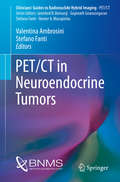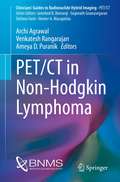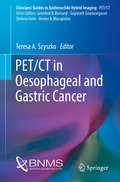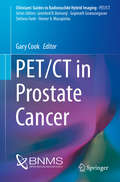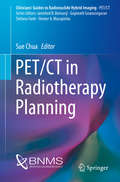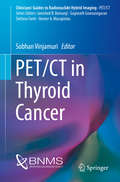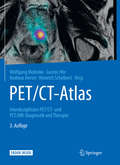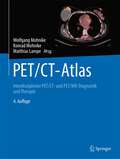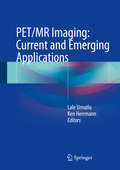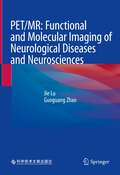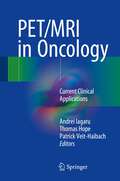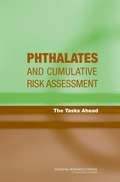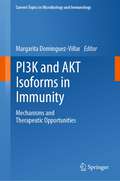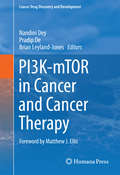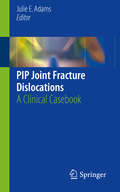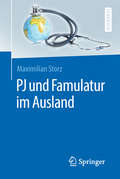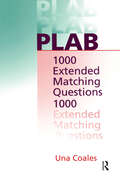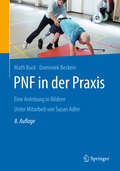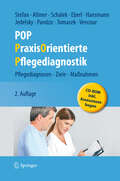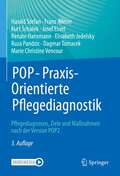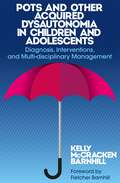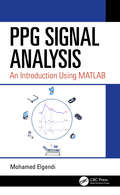- Table View
- List View
PET/CT in Neuroendocrine Tumors
by Stefano Fanti Valentina AmbrosiniThis pocket book provides up-to-date descriptions of themost relevant features of neuroendocrine tumors (NETs) and the imagingmodalities currently available to assist specialists (clinicians, pathologists,radiologists, nuclear medicine physicians) in selecting optimal patientmanagement based on interdisciplinary collaboration. As the title indicates,the focus is particularly on PET/CT, with coverage of basic principles, theavailable radiopharmaceuticals, indications, typical and atypical appearances, normalvariants and artifacts, advantages, limitations, and pitfalls. In addition, succinctinformation is provided on the use of other imaging modalities, includingSPECT, CT, and MRI, and on pathology and treatment options. Imaging teachingcases are presented, and key points are highlighted throughout. The book ispublished as part of a series on hybrid imaging that isspecifically aimed at referring clinicians, nuclear medicine/radiology physicians,radiographers/technologists, and nurses who routinely work in nuclear medicineand participate in multidisciplinary meetings.
PET/CT in Non-Hodgkin Lymphoma (Clinicians’ Guides to Radionuclide Hybrid Imaging)
by Archi Agrawal Venkatesh Rangarajan Ameya D. PuranikThis book provides an up-to-date summary of the latest scientific developments on the use of PET-CT imaging in Non-Hodgkin Lymphoma (NHL). It encompasses the entire spectrum of NHL – from pathology to radiological and PET-CT imaging and to the management of NHL. The highlight of the book is the excellent pictorial depiction of normal variants, pitfalls and artifacts while exploring the different types of NHL and its manifestations. Each chapter, written by well-known and experienced oncologists and physicians, is enriched by a wide range of images to ensure a clear concept of PET-CT imaging in NHL and will definitely keep the readers interested.This book will be a useful tool for nuclear physicians, radiologists, referring clinicians and oncologists, as well as para-medical staff working in this field.
PET/CT in Oesophageal and Gastric Cancer
by Teresa A. SzyszkoThis book is a pocket guide to the science and practice of PET/CT imaging of esophageal and gastric malignancies. The scientific principles of PET/CT, the radiopharmaceuticals used in this context, the role of PET/CT, the characteristic PET/CT findings, and limitations and pitfalls are all clearly described. In addition, information is provided on epidemiology, clinical presentation, diagnosis, staging, pathology, management, and radiological imaging. The book is published within the Springer series Clinicians' Guides to Hybrid Imaging, which is aimed at referring clinicians, nuclear medicine/radiology physicians, radiographers/technologists, and nurses who routinely work in nuclear medicine and participate in multidisciplinary meetings. Compiled under the auspices of the British Nuclear Medicine Society, the series is the joint work of many colleagues and professionals worldwide who share a common vision and purpose in promoting and supporting nuclear medicine as an important imaging specialty for the diagnosis and management of oncological and non-oncological conditions.
PET/CT in Prostate Cancer
by Gary CookThis pocket book explains the significant and well-documented impact that PET/CT can have on the management of prostate cancer through the provision of high-quality evidence regarding function and structure. Up-to-date information is supplied on the relevance of PET/CT to diagnosis, treatment planning, and therapy, including the emerging role of PET/CT with PSMA. Readers will also find clear explanation of the relation of the clinical and pathological background to imaging and the value of PET/CT compared with conventional radiological imaging. The book will be an excellent asset for referring clinicians, nuclear medicine/radiology physicians, radiographers/technologists, and nurses who routinely work in nuclear medicine and participate in multidisciplinary meetings. It is published within the Springer series Clinicians' Guides to Radionuclide Hybrid Imaging, which presents contributions from professionals worldwide who share a common purpose in promoting nuclear medicine as an important imaging specialty for the diagnosis and management of oncological and non-oncological conditions.
PET/CT in Radiotherapy Planning
by Sue ChuaThis pocket book offers a succinct but comprehensive overview of the role of PET/CT in radiotherapy planning. Individual chapters are devoted to specific application of the technique to particular tumor types, including non-small cell lung, gastrointestinal, head and neck squamous cell, prostate, gynecological, and pediatric tumors. Helpful information is also presented on the practical implementation of PET/CT in routine oncological practice. Technical and logistical issues are discussed, and guidance provided on potential problems and pitfalls and available solutions. The book will be invaluable in assisting readers to exploit PET/CT's ability to significantly improve delineation of tumor tissue through the addition of metabolic information to structural imaging data, thereby avoiding unnecessary radiation injury and associated complications while enhancing therapeutic effects and minimizing the risk of marginal recurrences. It is published within the Springer series Clinicians' Guides to Radionuclide Hybrid Imaging, compiled under the auspices of the British Nuclear Medicine Society.
PET/CT in Thyroid Cancer (Clinicians’ Guides to Radionuclide Hybrid Imaging)
by Sobhan VinjamuriThis pocket book provides a comprehensive review of the current use of PET/CT in thyroid cancer, offering a multidisciplinary perspective and explaining the role of PET/CT in relation to other imaging modalities. A key aim is to help readers to choose the correct imaging modality to answer the clinical question at hand, thereby assisting in patient management. Highlights of the book include the exquisite depiction of normal variants, pitfalls, and artifacts and a pictorial atlas of the types of thyroid cancer and their imaging appearances. Readers will also find helpful information on the relation of the clinical and pathological background to imaging. The book will be an excellent asset for practitioners and trainees in Nuclear Medicine and members of endocrine and oncology teams. It is published within the Springer series Clinicians’ Guides to Radionuclide Hybrid Imaging, in which leading professionals succinctly explain the importance of nuclear medicine in the diagnosis and management of oncological and non-oncological conditions.
PET/CT in Tuberculosis (Clinicians’ Guides to Radionuclide Hybrid Imaging)
by Dragana Sobic Saranovic Mariza Vorster Sanjay Gambhir Thomas Neil PascualThis book covers both the science of PET/CT imaging in tuberculosis and the impact that this technique can have on disease management through the provision of high-quality evidence regarding function and structure. The scientific principles of PET/CT, the radiopharmaceuticals used in the context of tuberculosis (FDG and non-FDG tracers), patient preparation, and imaging protocols are fully explained. Imaging findings obtained in different settings, including pulmonary and extrapulmonary tuberculosis, tuberculosis and HIV co-infection, and evaluation of response to antituberculous therapy, are described with the aid of many high-quality illustrations. Attention is drawn to mimics of tuberculosis, pitfalls, and limitations. The book will be an excellent asset for referring clinicians, nuclear medicine/radiology physicians, radiographers/technologists, and nurses who routinely work in nuclear medicine and participate in multidisciplinary meetings.
PET/CT-Atlas
by Wolfgang Mohnike Gustav Hör Andreas Hertel Heinrich SchelbertDieses Buch stellt in seiner 3. Auflage, mit fast 1600 Abbildungen eine konsequente Weiterentwicklung des erfolgreichen Buchkonzepts der Vorauflagen dar. Durch die Optimierung des Layouts für eine bessere Übersicht findet der Leser nun noch schneller die gesuchten Informationen. Inhaltlich liegt der Fokus nicht mehr allein auf der Diagnostik: sondern Therapie und Therapiesteuerung kommen in allen Abschnitten des Buches hinzu, was auch durch die Unterteilung des Buches in 4 große Hauptabschnitte zum Tragen kommt: Grundlagen Maligne Erkrankungen Therapiesteuerung Benigne Erkrankungen Es finden sich folgende inhaltliche Neuerungen: Abschnitt Therapiesteuerung mit neuen Kapiteln: PET/CT und PET/MR in der Strahlentherapie, PET/CT und PET/MR in der Brachytherapie, PET/CT in der Radionuklidtherapie, Neuroendokrine Tumoren in der Therapiekontrolle, PET/CT und PET/MR in der Chirurgie Komplettierung zahlreicher Fallbeispiele um die Strahlentherapie, einschließlich Therapiekontrolle Berücksichtigung neurodegenerativer Erkrankungen (z. B. Morbus Alzheimer, Morbus Parkinson) Radionuklidtherapie/neue Tracer
PET/CT-Atlas: Interdisziplinäre PET/CT- und PET/MR-Diagnostik und Therapie
by Wolfgang Mohnike Konrad Mohnike Matthias LampeDer PET/CT-Atlas in seiner 4. Auflage stellt eine konsequente Weiterentwicklung des erfolgreichen Buchkonzepts dar. Er soll Ärzten verschiedenster Fachrichtungen als Nachschlagewerk dienen, die Indikationsstellung erleichtern und den therapiesteuernden Einfluss der PET/CT bzw. PET/MR beleuchten.InhaltDas Buch ist in 5 Sektionen unterteilt – Grundlagen, Maligne Erkrankungen, Therapiemanagement, Benigne Erkrankungen und Zukunftstendenzen – innerhalb derer es eine Vielzahl inhaltlicher Neuerungen gibt, z. B.:- Grundlagen: Praktischer Leitfaden für die technische Konfiguration und klinische Anwendung- Benigne/maligne Erkrankungen: Berücksichtigung neurologischer und demenzieller Erkrankungen, neues Kapitel Tumoren der Schilddrüsen und Nebenschilddrüsen - Therapiemanagement: Rolle der PET in der onkologischen Chirurgie, Beurteilung des Ansprechens auf eine medikamentöse Tumortherapie, Potenzial der Theranostik- Zukunftstendenzen: Neue Tracer in der nuklearmedizinischen Diagnostik und Therapie, Möglichkeiten mit aktuellen Geräten, Entwicklung des ReimbursementsFür einen schnellen Überblick in allen Diagnostik- und Therapiekapiteln sorgt eine einheitliche Gliederung. Zahlreiche neue Fallbeispiele, praktische Tipps, die Darstellung der Erstattungssituation, Pitfalls und eine Take-Home-Message runden jedes Kapitel ab.In informativen und anschaulichen Beiträgen mit fast 1.000 Abbildungen beschreiben neben Fachärzten für Nuklearmedizin, Radiologie, Gynäkologie, Urologie, Chirurgie, Strahlentherapie uvm. auch Vertreter der Gesundheitspolitik, der geräteproduzierenden Industrie sowie Medizinphysiker und Radiochemikerdie vielschichtigen Aspekte der PET-Hybridbildgebung.HerausgeberProf. Dr. med. Wolfgang Mohnike Ärztlicher Direktor der ÜBAG MVZ DTZ am Frankfurter Tor/ MVZ DTZ am OZB Onkozentrum BerlinPriv.-Doz. Dr. med. Konrad Mohnike Ärztlicher Leiter des MVZ DTZ Berlin am Frankfurter Tor Dr. med. Matthias Lampe Ärztlicher Leiter des MVZ DTZ am OZB Onkozentrum Berlin
PET/MR Imaging: Current and Emerging Applications
by Ken Herrmann Lale UmutluThis book offers an excellent overview of the current applications of PET/MR imaging. Detailed information is provided on both its principal oncologic applications and its most important non-oncologic applications, such as assessment of cardiac disease, neurodegenerative brain imaging, and imaging of inflammatory disease. In addition, the future of PET/MR imaging is closely scrutinized, highlighting the anticipated major advances in the diagnostic value of hybrid imaging, the emerging role of PET/MR imaging in monitoring response in patients receiving targeted drug therapy, and progress toward the development of new tracers. An individual chapter is also devoted to pediatric imaging. The editors and authors are all well-known specialists in the field, with high levels of expertise in clinical applications and excellent publication records. The authors and editors represent both fields of hybrid imaging, in terms of nuclear medicine and radiology as to guarantee presentation of expertise and knowledge from both “worlds”. The book will be of value for all residents and consultants in radiology and nuclear medicine who have a dedicated interest in hybrid imaging.
PET/MR: Functional and Molecular Imaging of Neurological Diseases and Neurosciences
by Jie Lu Guoguang ZhaoThis book aims to summarize the research progress of integrated PET/MR brain function and molecular imaging, and more importantly, clinical application and research status of PET/MR of brain imaging from brain diseases to brain science. Starting from the overviews of brain function imaging technology, following chapters introduces clinical application of integrated PET/MR specific brain diseases in details, such as Alzheimer's disease, Parkinson's disease, epilepsy, and brain tumor, etc., which are hot issues of brain science research. It will be a useful reference to residents and practitioners in nuclear medicine, radiology, and neurology, as well as those interested in molecular imaging of brain.
PET/MRI in Oncology: Current Clinical Applications
by Thomas Hope Andrei Iagaru Patrick Veit-HaibachIn this book, experts from premier institutions across the world with extensive experience in the field clearly and succinctly describe the current and anticipated uses of PET/MRI in oncology. The book also includes detailed presentations of the MRI and PET technologies as they apply to the combined PET/MRI scanners. The applications of PET/MRI in a wide range of oncological settings are well documented, highlighting characteristic findings, advantages of this dual-modality technique, and pitfalls. Whole-body PET/MRI applications and pediatric oncology are discussed separately. In addition, information is provided on PET technology designs and MR hardware for PET/MRI, MR pulse sequences and contrast agents, attenuation and motion correction, the reliability of standardized uptake value measurements, and safety considerations. The balanced presentation of clinical topics and technical aspects will ensure that the book is of wide appeal. It will serve as a reference for specialists in nuclear medicine and radiology and oncologists and will also be of interest for residents in these fields and technologists.
PHEs, Environment and Human Health
by Claudio Bini Jaume BechThis book is dedicated to the occurrence and behaviour of PHEs in the different compartments of the environment, with special reference to soil. Current studies of PHEs in ecosystems have indicated that many industrial areas near urban agglomerates, abandoned or active mines, major road systems and ultimately also agricultural land act as sources and at the same time sinks, of PHEs and large amounts of metals are recycled or dispersed in the environment, posing severe concerns to human health. Thanks to the collaboration of numerous colleagues, the book outlines the state of art in PHEs research in several countries and is enforced with case studies and enriched with new data, not published elsewhere. The book will provide to Stakeholders (both Scientists Professionals and Public Administrators) and also to non-specialists a lot of data on the concentrations of metals in soils and the environment and the critical levels so far established, in the perspective to improve the environmental quality and the human safety.
PHTHALATES AND CUMULATIVE RISK ASSESSMENT: The Tasks Ahead
by National Research Council of the National AcademiesPeople are exposed to a variety of chemicals throughout their daily lives. To protect public health, regulators use risk assessments to examine the effects of chemical exposures. This book provides guidance for assessing the risk of phthalates, chemicals found in many consumer products that have been shown to affect the development of the male reproductive system of laboratory animals. Because people are exposed to multiple phthalates and other chemicals that affect male reproductive development, a cumulative risk assessment should be conducted that evaluates the combined effects of exposure to all these chemicals. The book suggests an approach for cumulative risk assessment that can serve as a model for evaluating the health risks of other types of chemicals.
PI3K and AKT Isoforms in Immunity: Mechanisms and Therapeutic Opportunities (Current Topics in Microbiology and Immunology #436)
by Margarita Dominguez-VillarThis book provides an essential overview of the role of phosphoinositide-3-phosphate kinase (PI3K) isoforms in modulating the function of immune system cells and their involvement in disease.PI3K is a family of kinases involved in basic cellular processes such as proliferation, migration and cell death. Recent work has highlighted the multiple roles of PI3K classes and subunits and their involvement in the immune response to the body’s own and foreign antigens and diseases such as cancer and autoimmunity. This book offers a detailed introduction to the biology of the three PI3K classes, followed by an extensive discussion of the diverse roles of AKT and PI3K isoforms in immune cells. Based on this knowledge, it subsequently explains in more detail how specific isoforms are connected to immune-mediated diseases. The book concludes by highlighting the latest advances in the production of isoform-specific inhibitors and their use in various human diseases. This book is intended as a reference guide for students and researchers interested in the multifaceted aspects of PI3K biology.
PI3K-mTOR in Cancer and Cancer Therapy
by Nandini Dey Pradip De Brian Leyland-JonesIn the post human-genome project era, cancer specific genomic maps are redesigning tumor taxonomy by evolving from histopathology to molecular pathology. The success of a cancer drug today is fundamentally based on the success in identifying target genes that control beneficial pathways. The overwhelming power of genomics and proteomics has enlightened researchers about the fact that the PI3K-mTOR pathway is the most commonly up-regulated signal transduction pathway in various cancers, either by virtue of its activation downstream of many cell surface growth factor receptors or by virtue of its collateral and compensatory circuitry with RAS-MAPK pathway. Oncogenic signaling in the majority of solid tumors is sustained via the PI3K-AKT-mTOR pathway. Because of its prominent role in many cancer types, the PI3K-mTOR pathway has become a major therapeutic target. The volume includes two complementary parts which address the problem of etiology and disease progression and is intended to portray the very basic mechanisms of the PI3K-AKT-mTOR signaling pathway's involvement in various facets of the cancer, including stem cell renewal, cell metabolism, angiogenesis, genetic instability, and drug resistance. Significant progress has been made in recent years elucidating the molecular mechanism of cancer cell proliferation, angiogenesis, and drug-resistance in relation to the PI3K-mTOR pathway and this volume provides an in-depth overview of recent developments made in this area.
PIP Joint Fracture Dislocations
by Julie E. AdamsComprised exclusively of clinical cases covering injuries to the proximal interphalangeal (PIP) joint, this concise, practical casebook will provide orthopedic surgeons and hand surgeons with the best real-world strategies to properly manage the multifaceted surgical techniques for management of the PIP. Each chapter is a case that opens with a unique clinical presentation, followed by a description of the diagnosis, assessment and management techniques used to treat it, as well as the case outcome and clinical pearls and pitfalls. Cases included illustrate both operative and non-operative treatment of volar fracture dislocations, dorsal block splinting and pinning, ORIF with screw fixation, volar plate and hemi hamate arthroplasty, PIP joint fusion, and pediatric PIP joint injuries, among others. Pragmatic and reader-friendly, PIP Joint Fracture Dislocations: A Clinical Casebook will be an excellent resource for orthopedic surgeons and Hand surgeons confronted with both common and complex fractures to the PIP joint.
PJ und Famulatur im Ausland (Springer-Lehrbuch)
by Maximilian Storz Sven GottschlingSie sind Medizinstudent und wollen Ihre Famulatur oder ein PJ-Tertial im Ausland absolvieren? Dann werden Sie bald auf eine Menge offener Fragen stoßen: Wohin soll es gehen? Wie und wann bewerbe ich mich? Mit welchen Kosten muss ich rechnen? Antworten auf diese und noch viele weitere Fragen finden Sie in diesem Buch. Knapp und übersichtlich ist alles enthalten, was man vor und nach der Abreise wissen muss: · Schritt für Schritt durch die Organisation des Auslandspraktikums · Überblick über die beliebtesten Länder · Tipps zum Klinikalltag · Hinweise zu kulturellen Aspekten · Checklisten und Vorlagen · Erfahrungsberichte · Fragen und Antworten am Ende der wichtigsten Kapitel Endlich kommt Licht in den Informationsdschungel und man muss sich die notwendigen Details nicht mehr mühsam zusammensuchen! Der Autor Dr. Maximilian Storz ist Assistenzarzt für Innere Medizin und lebt zur Zeit in Tübingen. Schon während diverser Auslandsaufenthalte in seiner Studienzeit (u. a. Südkorea, Dänemark und Schweiz) hat er intensiv an seinem Buch zum Thema Famulatur und praktisches Jahr im Ausland geschrieben.
PLAB: 1000 Extended Matching Questions
by Una F CoalesThis book is an essential purchase for all candidates sitting Part 1 of the PLAB exam administered by the UK General Medical Council. All doctors from non-EC countries who wish to practice in UK must sit the PLAB exam which comprises 200 Extended Matching Questions (EMQs). This book contains 1000 practice EMQs of a similar type to those in the exam.The questions cover all aspects of the new syllabus, which not only includes a range of clinical topics but also requires knowledge of the GMC's Duties of a Doctor, principles and practice of evidence-based medicine, and clinical governance. Recommended to all candidates sitting the new PLAB test.
PNF in der Praxis: Eine Anleitung in Bildern (Rehabilitation Und Prävention Ser. #22)
by Dominiek Beckers Math BuckVon neurophysiologischen Grundlagen über Befunderhebung und Behandlungstechniken bis hin zu PNF-Pattern – Lernen Sie mit diesem Praxis- und Lehrbuch Schritt für Schritt alle Facetten der Propriozeptiven Neuromuskulären Fazilitation kennen und werden Sie zum Experten dieser etablierten Methode.In diesem Buch finden Sie: Grundlagen der PNF (inklusive PNF-Philosophie, ICF-Modell, motorisches Lernen u.v.m.), PNF-Patterns und ihre funktionelle Anwendung präzise und verständlich erklärt, über 640 farbige Abbildungen für die anschauliche Darstellung aller wichtigen Techniken und Behandlungsschritte, Behandlungsbeispiele und zahlreiche Praxistipps für eine unkomplizierte Umsetzung im therapeutischen Alltag, Fragen am Ende jedes Kapitels zur Kontrolle Ihres LernerfolgsNeu in der 8. Auflage: Vollständig aktualisiert, Vorstellung der Internationalen PNF Association, zusätzliche Anwendungsmöglichkeiten und Patientenbeispiele Ein Muss für alle, die PNF lernen möchten oder bereits anwenden!
POCUS in Critical Care, Anesthesia and Emergency Medicine
by Noreddine Bouarroudj Peňafrancia C. Cano Shahridan bin Mohd Fathil Habiba HemamidThis book describes Emergency Ultrasound (EFAST echo, Lung Ultrasound, Vascular Ultrasound and Transthoracic Echocardiograhy) and all ultrasound technics in Anesthesia practice, i.e. Gastric Ultrasound, Airway Ultrasound and Ultrasound guided vascular access.The book is divided into 11 sections and each section is devoted to a well-defined topic that are further investigated in the dedicated chapters richly and fully illustrated with colored and detailed sonoanatomy drawings. The volume represents a very useful, practical and highly didactic tool.It presents concise up-to-date and evidence-based knowledge in POCUS and explains the use and benefits of ultrasound for intensivists, anesthesiologists, emergency specialists and allied professionals, as well.
POP - PraxisOrientierte Pflegediagnostik
by Elisabeth Jedelsky Dagmar Tomacek Renate Hansmann Ruza Pandzic Franz Allmer Josef Eberl Harald Stefan Kurt Schalek Marie Christine VencourPraxisOrientierte Pflegediagnostik steht für ressourcenorientiertes Diagnostizieren. Dabei werden Potenziale, Risiken und Defizite von Patienten gleichermaßen berücksichtigt. Die Autoren stellen in dem Band über 150 Pflegediagnosen vor: mit klaren Definitionen, konkreten Ressourcen sowie pflegerelevanten Ätiologien und Risikofaktoren. Für die 2. Auflage wurden Erfahrungen mit der Erstauflage eingearbeitet, neue Pflegephänomene aufgenommen und Diagnosen ergänzt. Mit beiliegender CD-ROM und pflegediagnoseorientiertem Anamnesebogen als Hilfsmittel.
POP - PraxisOrientierte Pflegediagnostik: Pflegediagnosen, Ziele und Maßnahmen nach der Version POP2
by Elisabeth Jedelsky Dagmar Tomacek Renate Hansmann Ruza Pandzic Franz Allmer Josef Eberl Harald Stefan Kurt Schalek Marie Christine VencourPraxisOrientierte Pflegediagnostik steht für ressourcenorientiertes Diagnostizieren. Dabei werden Potenziale, Risiken und Defizite von Patienten gleichermaßen berücksichtigt. Die Autoren stellen in dem Band über 150 Pflegediagnosen vor: mit klaren Definitionen, konkreten Ressourcen sowie pflegerelevanten Ätiologien und Risikofaktoren. Für die 2. Auflage wurden Erfahrungen mit der Erstauflage eingearbeitet, neue Pflegephänomene aufgenommen und Diagnosen ergänzt. Mit beiliegender CD-ROM und pflegediagnoseorientiertem Anamnesebogen als Hilfsmittel.
POTS and Other Acquired Dysautonomia in Children and Adolescents: Diagnosis, Interventions, and Multi-disciplinary Management
by Kelly Mccracken Barnhill Fletcher BarnhillThis is an authoritative overview for anyone encountering Postural Orthostatic Tachycardia Syndrome (POTS) - a dysfunction of the autonomic nervous system resulting in diverse symptoms experienced in an upright position that are relieved by lying down - and other types of acquired dysautonomia. It provides essential information on the symptoms, diagnosis and treatment in children and young people. Post-viral syndromes can be extremely difficult to manage and the average individual spends two to three years accessing appropriate diagnosis. This book provides necessary information for parents and healthcare professionals on identifying POTS and other post-viral dysautonomia, the most common triggers, appropriate intervention and successful multi-disciplinary management in both short and long term situations. It also includes helpful tips and coping strategies for managing the syndrome at home and in educational and clinical settings.
PPG Signal Analysis: An Introduction Using MATLAB®
by Mohamed ElgendiThis book serves as a current resource for Photoplethysmogram (PPG) signal analysis using MATLAB®. This technology is critical in the evaluation of medical and diagnostic data utilized in mobile devices. Information and methodologies outlined in the text can be used to learn the empirical and experimental process (including data collection, data analysis, feature extractions, and more) from inception to conclusion. This book also discusses how introduced methodologies can be used and applied as tools that will teach the user how to validate, test, and simulate developed algorithms before implementing and deploying the algorithms on wearable, battery-driven, or point-of-care devices.
